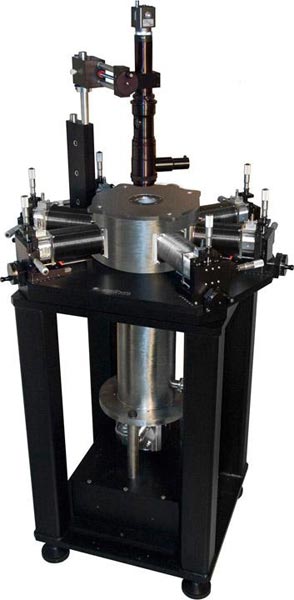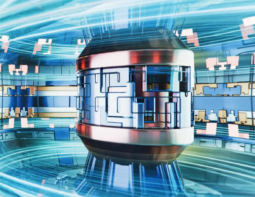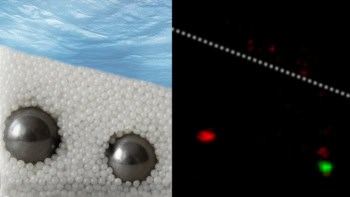
Many condensed-matter physicists around the world are working hard to develop new nanometre-scale technologies for magnetic data storage, spintronics and quantum computing. While the materials and processes that are used can vary greatly, much of this development work involves making very precise measurements at low temperatures, in high magnetic fields or both. Both environments can be very unforgiving on sensor technologies, but one company seeking to help the condensed-matter community in this regard is Lake Shore Cryotronics of Westerville, Ohio, US.
Founded in April 1968 by brothers John and David Swartz, the firm makes tools for the characterization of materials in environments in which the temperature and magnetic fields can vary greatly. John Swartz — who went on to run the company until his retirement in 2004 — was originally a professor of electrical engineering at Ohio State University (OSU) in Columbus. In its early years, the company was run from the basement of John Swartz’s family home and he continued to work at OSU until the mid-1970s. The Swartz brothers split the business in 1980, with David leaving to pursue other interests in cryogenics. John Swartz continues to serve as the company’s chairman.
Lake Shore was instrumental in developing the physics of diodes used as cryogenic temperature sensors Michael Swartz, Lake Shore Cryotronics
The privately held firm began by making 35 gallium-arsenide diode temperature sensors for the Argonne National Laboratory. Since then, such sensors have been a key part of the firm’s business and the company’s current president and chief executive Michael Swartz — who is John’s son — told physicsworld.com that “Lake Shore was instrumental in developing the physics of diodes used as cryogenic temperature sensors”. Michael Swartz also points out that the sensors themselves have been used in a number of significant scientific breakthroughs over the years, including the discovery of high-temperature superconductivity in 1986.
Today, the compnay offers a wide range of instrumentation and sensors for cryogenic applications. Temperatures down to 20 mK can be measured and controlled using its controllers, monitors, transmitters and AC resistance bridge. Lake Shore’s resistive temperature sensors include those made from Cernox — a material that performs very well in high magnetic fields. The company also supplies silicon and GaAlAs diode sensors and thermocouple wire.
Fibre Bragg gratings
The firm is now developing a completely new type of temperature sensor that is based on fibre Bragg gratings. These are sections of optical fibre that have a periodic change in refractive index. If light at a specific wavelength is transmitted along the fibre, it is reflected by the grating. The wavelength at which reflection occurs is very sensitive to the temperature of the grating, which means that such gratings can be used as temperature sensors.
Since these sensors are based on the transmission of light through an insulating fibre, they can be used in experiments that involve high voltages. They also have the potential to be immune to interference from extremely high magnetic fields. According to Michael Swartz, several sensors could be developed along the same fibre by creating gratings that operate at different wavelengths at different positions. In this way, one fibre could be used to measure the temperature at several different places in an experiment.
The challenge, according to Swartz, is how to package the gratings so that the fibres are isolated from vibrations and other mechanical stresses that can shift the wavelength of the reflected light — thereby degrading the performance of fibre Bragg sensors. Swartz told physicsworld.com that the company plans to launch commercial fibre Bragg temperature sensors on the market later this year.
Magnetic measurements
Over the years, Lake Shore’s product portfolio has been extended to include a line of instruments and sensors for making magnetic measurements. These include magnet power supplies, as well as vibrating sample magnetometer (VSM) and Hall effect measurement (HMS) systems for characterizing the magnetic and electronic transport properties of materials.
Most recently, the firm has added a line of cryogenic micro-manipulated probe stations to its portfolio. The latest probe station is the Model CRTTP6-4K, which is the company’s first probe station based on a closed-cycle refrigerator (CCR). Unlike conventional probe stations, the CCR platform is not cooled by liquid helium, which is becoming increasingly expensive. Such probe stations can be used to measure the electrical, electro-optical and magneto-transport properties of nanometre-scale electronic and magnetic materials.
According to Michael Swartz, the company’s philosophy has been to continually reinvest in itself — indeed, he says that the firm’s R&D budget is double the national average for instrumentation companies. While Lake Shore constantly seeks new markets for its technology and acquires new ideas and patents, Michael Swartz told physicsworld.com that the development of innovative cryogenic temperature-sensing technology remains a primary area of focus for the company.
We genuinely feel that we often kindle that spark of interest for some students to pursue science and physics as their field of study Michael Swartz, Lake Shore Cryotronics
Like many hi-tech companies, one of Lake Shore’s biggest challenges, according to Swartz, is finding good people. To do so, the company has developed a “long-range recruitment” strategy that goes so far as to invite high-school students into the company to give them a taste of what it is like working for a hi-tech company. According to Swartz, the students are fascinated by the impact the firm’s research tools have on their everyday lives — for example, through their use in the development of mobile phones and laptop computers. “We genuinely feel that we often kindle that spark of interest for some students to pursue science and physics as their field of study,” says Swartz.



